Bezel settings offer unmatched protection for your gemstones while maintaining a sleek, modern appearance. You’ll benefit from a secure fit that prevents snagging on clothing and conceals minor flaws in your stones. Their low-profile design reduces dirt accumulation and requires less maintenance than prong settings. Whether you’re active or simply love clean lines in your jewelry, bezels provide both practical security and sophisticated style. Discover how this versatile setting can transform your jewelry collection.
Understanding Bezel Settings in Modern Jewelry Design

While many setting styles come and go with changing trends, bezel settings have established themselves as a cornerstone of contemporary jewelry design.
These distinctive settings encase your gemstone within a metal rim, creating a sleek, modern look that appeals to minimalist sensibilities.
You’ll find bezel settings in various forms—from full bezels that completely surround the stone to partial options that expose portions of the gem.
This versatility allows you to personalize your jewelry while enjoying practical benefits. The design cleverly conceals internal flaws in gemstones, making them perfect for stones with minor imperfections.
For your active lifestyle, bezel settings offer a practical advantage: their low-profile design reduces snagging risks, keeping your precious stones secure during daily activities while maintaining a sophisticated appearance.
Essential Tools and Materials for Bezel Setting Creation
Creating beautiful bezel settings requires specific tools including bezel blocks, jeweler’s saws, and soldering equipment you’ll need to master.
You’ll want to carefully select your metals—whether gold, silver, or platinum—considering both aesthetic appeal and how they’ll interact with your chosen gemstone.
Your precision measuring tools, such as calipers and dividers, will prove invaluable for ensuring your bezel perfectly accommodates your stone’s dimensions.
Essential Bezel Setting Tools
The right tools make all the difference when crafting professional bezel settings for your jewelry pieces.
You’ll need a quality bezel pusher to secure the metal around your gemstone without causing damage – this essential tool guarantees your stone sits snugly in place.
For precise customization, a metal saw helps you cut bezel strips to the exact length and shape needed for different gemstone dimensions.
Don’t forget your soldering kit (torch, solder, and flux) to join the bezel to your backing, creating durable, lasting jewelry.
After shaping, use a burnisher to smooth and polish the bezel edges for a refined finish.
Complete your toolkit with flat-nose or round-nose pliers to bend and shape the bezel wire, allowing it to conform perfectly to your gemstone’s unique contours.
Metal Selection Matters
Selecting the right metal for your bezel setting fundamentally shapes both the aesthetic appeal and longevity of your jewelry piece. The metal you choose will interact with your gemstone’s color, either enhancing or diminishing its natural brilliance.
When selecting metals for your bezel setting, consider:
- Durability factors – platinum offers superior resilience for daily wear pieces
- Color complementation – yellow gold enhances warm-toned gems, while white metals accentuate cooler hues
- Thickness requirements – the metal rim must be substantial enough to secure the stone without adding excessive weight
- Workability – different metals require specific tools like bezel pushers and burnishers for proper setting
Remember that your metal choice isn’t merely decorative—it’s structural. The right metal guarantees your bezel setting will protect your gemstone while showcasing its beauty for years to come.
Precision Measuring Equipment
Because precision forms the foundation of successful bezel setting work, investing in quality measuring equipment isn’t optional—it’s essential.
You’ll need calipers and micrometers to accurately determine your gemstone’s dimensions, ensuring your bezel setting is one that fits perfectly around the stone.
A jeweler’s saw allows you to cut metal sheets with exactness, while ring mandrels help maintain consistent band sizing and curvature for comfortable wear.
Don’t overlook the importance of digital scales for measuring metal weight—they’re vital for cost calculations and material management.
Complete your toolkit with a sturdy bench block, providing the solid surface needed for hammering and shaping metals.
These tools work together to transform your design vision into a durable, precisely crafted bezel setting that showcases your gemstone beautifully.
Measuring and Cutting Metal for Your Bezel
Accurate measurements form the foundation of a successful bezel setting, as even minor miscalculations can lead to a poorly fitted gemstone.
When measuring for your metal frame, always account for the gemstone’s complete dimensions—width, height, and depth—to guarantee a perfect fit.
Cut your metal slightly larger than the stone’s measurements to allow for adjustments during the forming process. Remember that the metal’s thickness will affect your final bezel’s appearance, so factor this into your calculations.
- Use precision cutting tools like a jeweler’s saw for clean edges
- Measure twice, cut once to avoid wasting precious metal
- Allow 1-2mm extra material beyond your stone’s dimensions
- Shape your cut bezel using a mandrel to create the proper curvature
Soldering Techniques for Perfect Bezel Joins
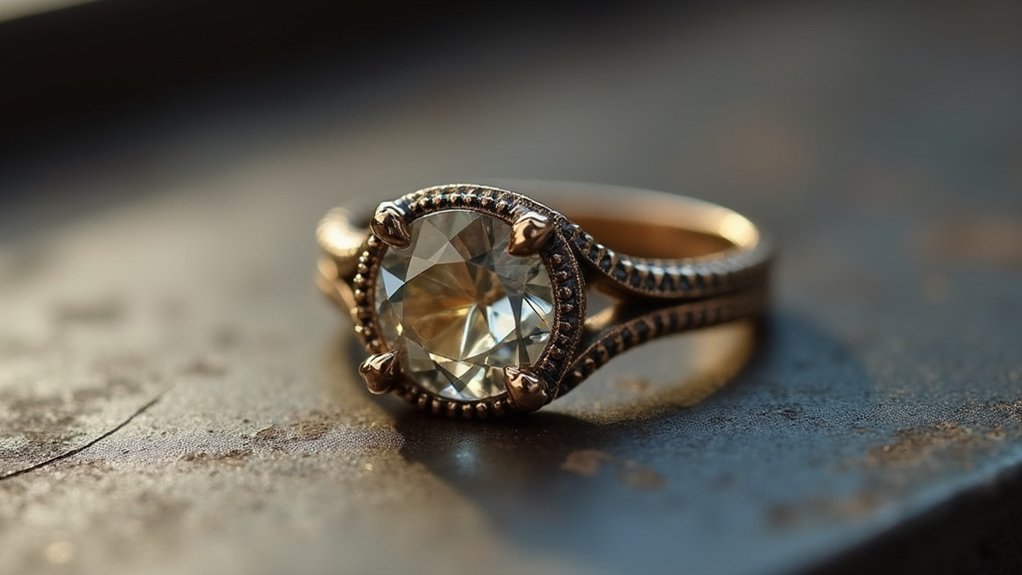
When soldering bezels, you’ll need to select the right tools including a temperature-controlled torch, soldering pick, and third-hand tools to guarantee precise placement.
You can maintain perfect heat control by working in zones, starting with a broader flame to warm the piece and then focusing on the join with a smaller, more precise flame.
Apply flux generously but precisely to the join areas, wiping away excess before heating to prevent contamination while guaranteeing proper solder flow.
Tool Selection Fundamentals
Three essential tools form the foundation of successful bezel soldering: a quality torch, appropriate solder, and proper cleaning materials. When setting gemstones in bezels, your tools directly impact the durability and appearance of the final piece.
- Choose a soldering iron or torch with adjustable temperature settings to prevent overheating delicate bezel materials.
- Select solder hardness (hard, medium, or easy) based on your bezel thickness—thicker bezels typically require harder solders for strength.
- Invest in quality cleaning solutions like pickle compounds to remove oxidation before and after soldering.
- Add fine abrasives to your toolkit for preparing metal surfaces, ensuring ideal bond strength when joining bezel sections.
With these fundamentals in place, you’ll create clean, strong joins that securely hold your stones while maintaining the elegant look that makes bezel setting so appealing.
Heat Control Strategies
Mastering heat control stands as the most critical skill for creating seamless bezel joins that last. When soldering your bezel setting, use a torch with adjustable flame settings to distribute heat evenly across the metal surface. This prevents warping and distortion that could compromise your setting’s integrity.
Always apply flux before soldering to improve adhesion and prevent oxidation that weakens joins. Position a heat sink near gemstones or delicate components to protect them from excessive heat damage.
Remember that different metals require specific soldering techniques—you’ll need to monitor the melting points of both your bezel material and solder type. Too little heat creates weak bonds, while too much can discolor your metal or damage gemstones.
With practice, you’ll develop the precise touch needed for perfect bezel joins every time.
Flux Application Methods
Proper flux application serves as the foundation for successful bezel soldering, ensuring your joins achieve both strength and aesthetic appeal.
When applying flux to your bezel setting, you’ll need to be methodical to prevent oxidation during the heating process.
- Choose between paste or liquid flux based on your specific metal type—paste flux works well for precise applications on small bezel areas.
- Apply flux to both the bezel and backing surfaces before positioning your solder, ensuring complete coverage where the join will occur.
- Use a small brush for controlled application, avoiding excess that could cause the solder to flow unpredictably.
- Clean your brush between applications to prevent contamination that might weaken your joins.
Filing and Shaping Your Bezel Setting
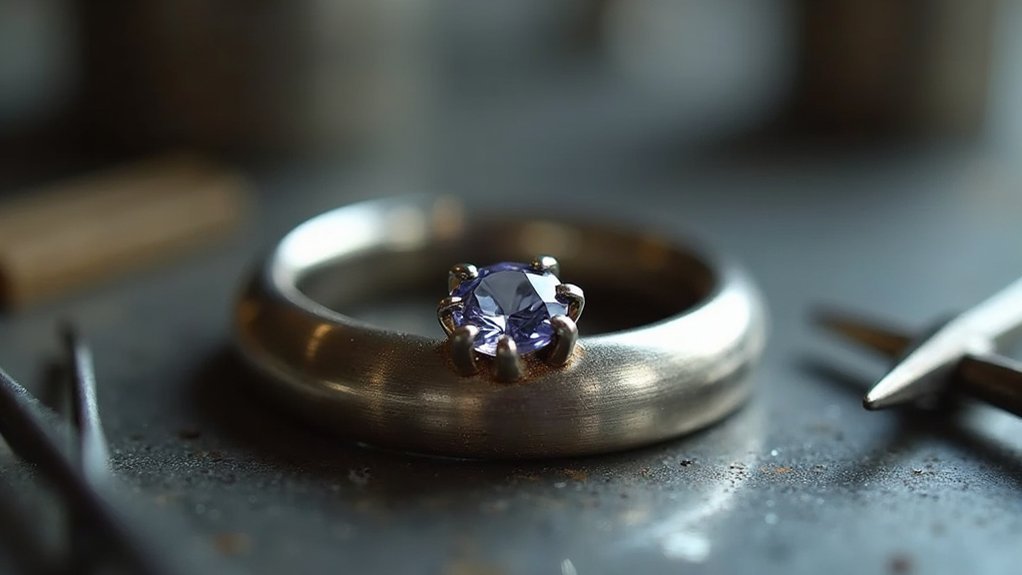
Crafting the perfect bezel setting demands precision and attention to detail as you shape the metal to embrace your gemstone. When filing your bezel, you’ll need to carefully smooth the edges to match your stone’s specific dimensions, ensuring both security and visual appeal.
Use specialized tools like fine files and sanding discs to achieve the ideal contour. Work methodically around the bezel, maintaining consistent pressure to create an even edge that will hold your gemstone securely.
Pay close attention to the upper edge where the metal will eventually be burnished over the stone.
After shaping, don’t skip polishing the bezel to remove scratches and imperfections. This final touch not only enhances the setting’s appearance but also prevents potential damage to your precious gemstone during the setting process.
Preparing the Base Plate for Your Design
The foundation of your bezel setting begins with a carefully prepared base plate, which will support and showcase your gemstone. Selecting high-quality metals like gold or platinum guarantees your base plate resists corrosion and maintains structural integrity over time.
Your bezel setting’s future brilliance depends entirely on starting with a premium metal base that won’t deteriorate with wear.
Before attaching the metal rim, you’ll need to:
- Measure your gemstone precisely to create a perfectly sized base plate
- Determine the ideal thickness—thicker for protection, thinner for delicacy
- Polish the surface thoroughly to achieve a professional finish
- Clean the plate meticulously to guarantee proper adhesion with the bezel
The relationship between your base plate and metal rim creates the secure cradle that will hold your precious stone.
Taking time with this preparatory step assures your bezel setting won’t only look beautiful but provide lasting protection for your gemstone.
Setting Stones in a Bezel: Step-by-Step Process
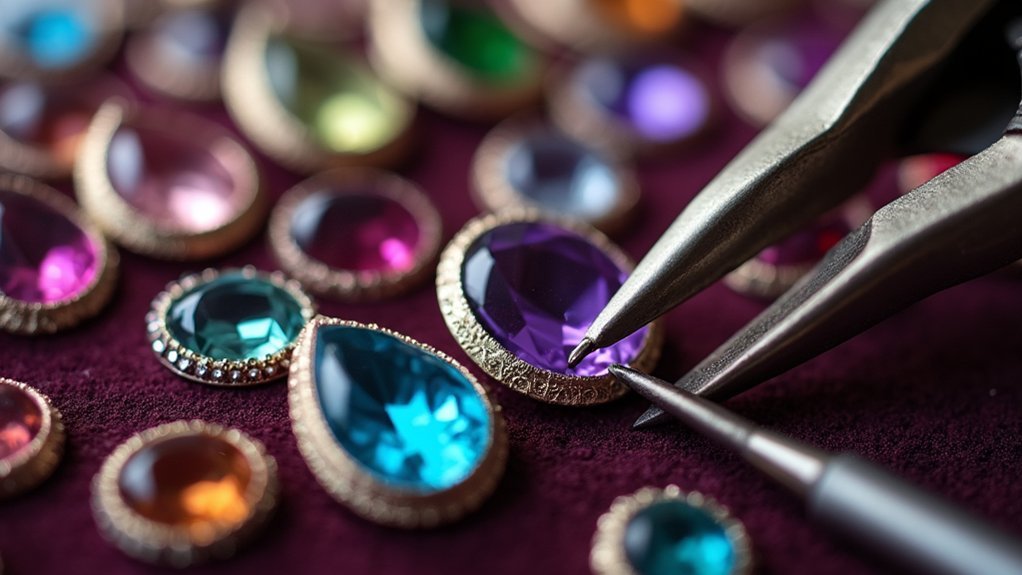
Five essential steps transform raw materials into a stunning bezel-set piece of jewelry.
First, measure your gemstone with precision, accounting for its unique shape to guarantee proper placement.
Next, cut a metal bezel strip and shape it into a custom frame that will securely hold your stone without causing damage.
Once shaped, form the strip into a complete ring and solder the ends together, creating a solid foundation for your gemstone.
Then carefully position the stone within the bezel, ensuring it sits perfectly flush against the metal. Use a bezel pusher to gently fold the edges over the stone, securing it in place.
Finally, polish the entire setting to enhance its luster and eliminate any imperfections, showcasing your gemstone’s natural beauty.
Polishing and Finishing Your Bezel Creation
Once your stone is securely set, polishing and finishing work transforms your bezel creation from merely functional to professionally stunning. The right polishing techniques can greatly enhance your jewelry’s appearance and longevity.
- Use a non-abrasive polishing cloth to gently buff the metal frame, avoiding contact with the gemstone to prevent scratching.
- Consider the specific metal type in your bezel—gold responds well to a soft cloth, while platinum may require specialized compounds.
- For intricate bezel designs, professional polishing services guarantee preservation of detailed work.
- Implement regular maintenance by cleaning with mild soap and water to prevent dirt buildup that dulls the metal’s shine.
Remember that proper polishing and routine maintenance not only enhance your bezel setting’s beauty but also protect your investment for years to come.
Troubleshooting Common Bezel Setting Challenges
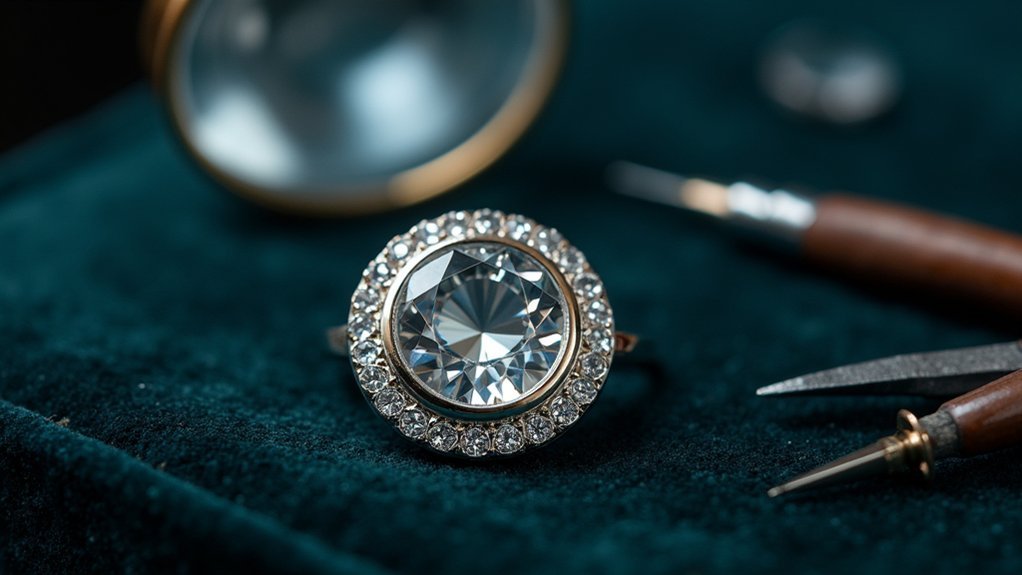
Despite their protective qualities, bezel settings present unique challenges that can frustrate even experienced jewelers. When weighing the pros and cons of this setting style, you’ll need to evaluate maintenance requirements that guarantee your jewelry’s longevity.
| Challenge | Solution |
|---|---|
| Visible dents and scratches | Schedule periodic professional maintenance |
| Accumulated debris | Clean regularly to maintain stone brilliance |
| Limited stone visibility | Select well-cut gemstones to maximize light |
| Tight setting pressure | Confirm proper sizing to prevent stone damage |
| Brilliance concerns | Assess partial bezel settings for better light exposure |
Remember that while bezel settings offer superior protection for your gemstones, they require attentive care. If you notice your stone losing its sparkle, it’s likely time for a cleaning. For persistent issues, don’t hesitate to consult a professional jeweler who can address these common challenges.
Advanced Bezel Variations for Unique Designs
You’ll find endless creative possibilities with multi-metal bezel frames that combine gold, silver, or platinum for striking visual contrast around your gemstone.
Hidden accent stones can be nestled within the bezel lip, adding unexpected sparkle that’s only visible from certain angles.
These advanced techniques allow you to express your personal style while maintaining the protective benefits of traditional bezel settings.
Multi-Metal Bezel Frames
Innovation in jewelry design reaches new heights with multi-metal bezel frames, where two or more metals combine to create visually striking settings. Your personal preference can truly shine with these customizable options that elevate ordinary jewelry into wearable art.
- Contrast gold with platinum or mix rose gold with silver to achieve unique color combinations that make your gemstone pop.
- Benefit from each metal’s unique properties—durability from platinum, warmth from gold, or hypoallergenic qualities from titanium.
- Accommodate any gemstone shape or size with precision-crafted bezels that enhance both security and beauty.
- Express your contemporary style through these modern designs that stand apart from traditional single-metal settings.
Multi-metal bezel frames offer the perfect solution when you’re seeking something distinctive that reflects your personality while maintaining the protective advantages of traditional bezels.
Hidden Accent Stones
While traditional bezels showcase a single gemstone, advanced bezel variations with hidden accent stones offer a sophisticated twist to your jewelry collection.
These subtle additions incorporate smaller gemstones within the bezel structure, enhancing the piece’s brilliance without overwhelming the main stone.
You’ll find these accent stones strategically placed around your primary gem or integrated directly into the bezel itself, allowing for personalized customization that reflects your unique style.
Advanced bezel settings with hidden accents serve dual purposes—they cleverly conceal any imperfections while adding visual interest and dimension.
The variety of shapes and sizes available for these accent stones creates depth and balance in your jewelry design.
You’ll enjoy increased sparkle and luxury, making your piece appear more thoughtfully crafted while maintaining the clean, protective advantages of a bezel setting.
Caring for Your Bezel-Set Jewelry Pieces
Proper maintenance of your bezel-set jewelry guarantees its longevity and preserves its beauty for years to come. While bezel settings offer excellent protection for your precious stones, regular care is still essential, especially for frequently worn pieces like engagement rings.
- Clean your jewelry regularly with mild soap and a soft cloth to maintain its luster and prevent dirt accumulation around the metal rim.
- Consider professional cleaning for intricate pieces to avoid accidental damage to the setting or gemstone.
- Store your pieces in soft pouches or lined jewelry boxes when not wearing them to prevent scratches.
- Avoid exposure to harsh chemicals and abrasive materials that could damage both the metal setting and the gemstone.
Caring for your bezel-set jewelry is relatively straightforward since these settings have fewer crevices than other styles.
Bezel Setting Projects for Different Skill Levels
Creating beautiful bezel-set jewelry is accessible to crafters at every skill level, from complete novices to master artisans.
If you’re just starting out, focus on full bezel settings for cabochons, which are more forgiving and easier to handle than faceted stones.
As your confidence grows, try partial bezel settings that securely hold your gemstones while showcasing their unique shapes and facets.
These intermediate projects enhance your design skills while maintaining security.
Advanced jewelers can explore custom bezel engagement pieces using various metals like gold, silver, or platinum—each offering different aesthetic qualities and durability levels.
Consider incorporating accent stones around your main bezel for truly spectacular statement pieces.
The versatility of bezel settings allows you to create increasingly complex designs as your technical abilities and artistic vision evolve.
Frequently Asked Questions
What Are the Disadvantages of a Bezel Setting?
Bezel settings reduce your gemstone’s brilliance by limiting light entry. They’ll make stones appear smaller, show wear on the metal rim, trap dirt that’s hard to clean, and cost more due to complex craftsmanship.
Is a Bezel Setting More Secure Than Prongs?
Yes, bezel settings are more secure than prongs. They completely encircle your gemstone with metal, preventing snagging and protecting against chips. You won’t worry about stones loosening or catching on clothing during daily activities.
Does Bezel Setting Make Stones Look Smaller?
Yes, bezel settings can make your stones look smaller because the metal surrounds the gem completely. You’ll notice this effect especially with smaller stones, though partial bezels offer a compromise by revealing more of the gemstone.
Are Bezel Settings Less Sparkly?
Yes, bezel settings are typically less sparkly. You’ll notice they limit light exposure by surrounding the stone with metal, reducing brilliance compared to prong settings. However, their sleek look and protection often outweigh this drawback.
In Summary
Whether you’re a beginner or seasoned jeweler, bezel settings offer security, protection, and endless design possibilities for your gems. You’ll find they complement both modern and vintage styles while allowing your creativity to shine. As you’ve seen, with the right tools and techniques, you can create stunning bezel settings that showcase your stones beautifully. Remember to maintain your pieces properly, and you’ll enjoy their timeless elegance for years to come.

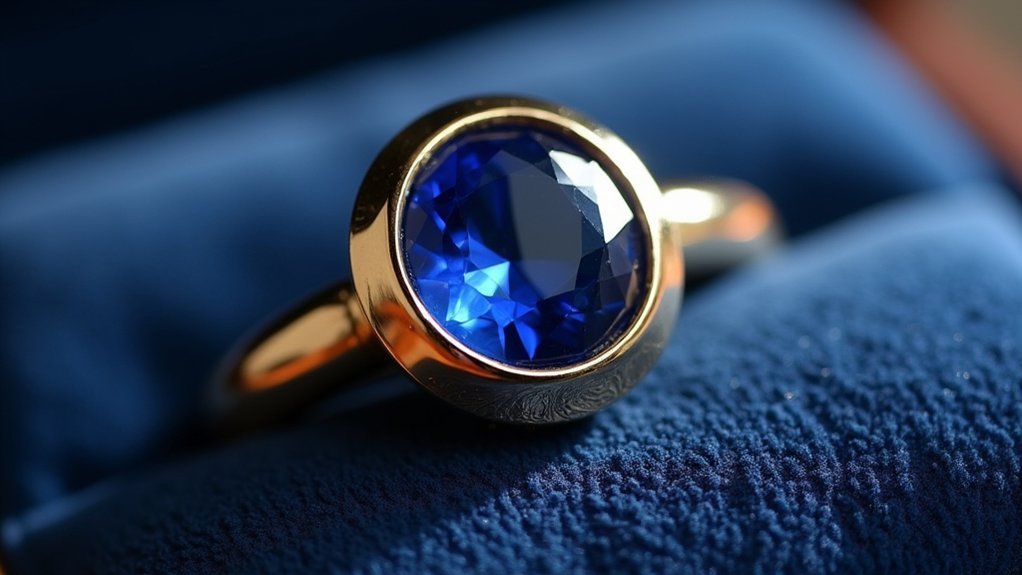



Leave a Reply